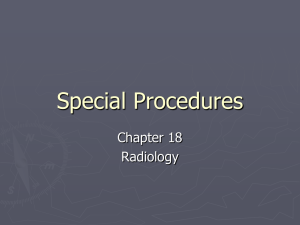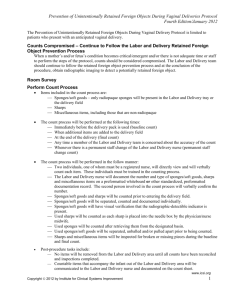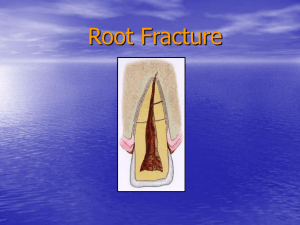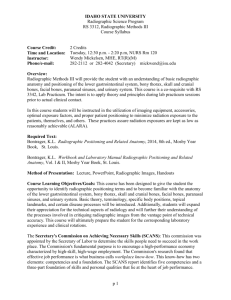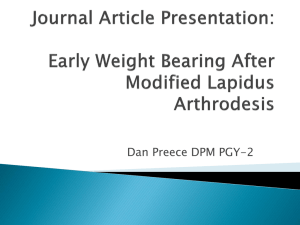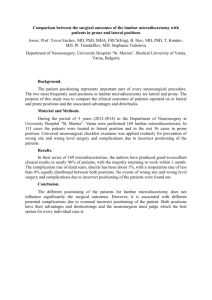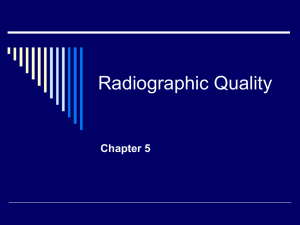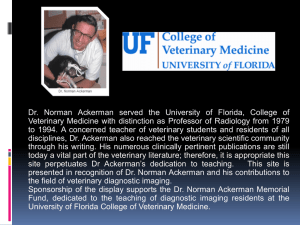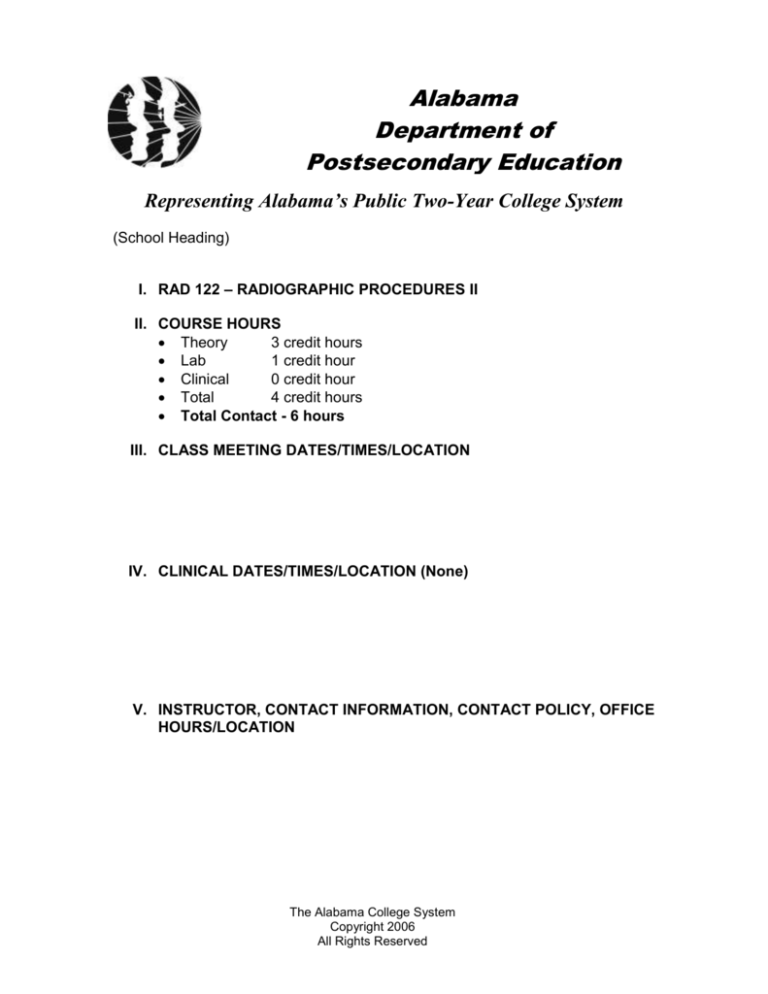
Alabama
Department of
Postsecondary Education
Representing Alabama’s Public Two-Year College System
(School Heading)
I. RAD 122 – RADIOGRAPHIC PROCEDURES II
II. COURSE HOURS
Theory
3 credit hours
Lab
1 credit hour
Clinical
0 credit hour
Total
4 credit hours
Total Contact - 6 hours
III. CLASS MEETING DATES/TIMES/LOCATION
IV. CLINICAL DATES/TIMES/LOCATION (None)
V. INSTRUCTOR, CONTACT INFORMATION, CONTACT POLICY, OFFICE
HOURS/LOCATION
The Alabama College System
Copyright 2006
All Rights Reserved
Radiographic Procedures II
RAD 122
VI. COURSE DESCRIPTION:
This course provides the student with instruction in anatomy and
positioning of spine, cranium, body systems and special procedures.
Theory and laboratory exercises will cover radiographic positions and
procedures with applicable contrast media administration.
Upon
completion of the course the student will demonstrate knowledge of
anatomy and positioning skills, oral communication and critical thinking in
both the didactic and laboratory settings.
VII. PREREQUISITE(S)/CO-REQUISITE(S)
CO-REQUISITE COURSES
PROFESSIONAL COMPETENCIES
VIII. TEXTBOOK(S) AND OTHER LEARNING RESOURCES
ACS Copyright 2006
All Rights Reserved
2
Radiographic Procedures II
RAD 122
IX. PROFESSIONAL COMPETENCIES/OBJECTIVES
MODULE A – ANATOMY AND POSITIONING OF VERTEBRAL COLUMN,
SACRUM AND COCCYX
A1.0 Position patients and produce images of the specified system.
A1.1 Position patients for examinations of the vertebral column,
sacrum, and coccyx.
A1.1.1 Explain general procedural considerations for radiographic
examinations.
A1.1.2 Identify equipment and supplies necessary to complete
radiographic procedures.
A1.1.3 Identify patient preparation processes for specific
radiographic procedures.
A1.1.4 Explain the routine and special views for specific
radiographic procedures.
A1.1.5 Explain specific radiographic procedures to patients.
A1.2 Use radiographic equipment to produce images of the
vertebral column, sacrum, and coccyx.
A1.2.1 Explain general radiation safety and protection practices
associated with specific radiologic examinations.
A1.2.2 Describe pertinent anatomical structures related to specific
radiographic procedures.
A1.2.3 Evaluate images for positioning, centering, appropriate
anatomy and overall image quality.
MODULE B – ANATOMY AND POSITIONING OF CRANIUM AND FACIAL
BONES
B1.0 Position patients and produce images of the specified system.
B1.1 Position patients for examinations of the cranium and facial
bones.
B1.1.1 Explain general procedural considerations for radiographic
examinations.
B1.1.2 Identify equipment and supplies necessary to complete
radiographic procedures.
B1.1.3 Identify patient preparation processes for specific
radiographic procedures.
B1.1.4 Explain the routine and special views for specific
radiographic procedures.
B1.1.5 Explain specific radiographic procedures to patients.
B1.2 Use radiographic equipment to produce images of the
cranium and facial bones.
B1.2.1 Explain general radiation safety and protection practices
associated with specific radiologic examinations.
B1.2.2 Describe pertinent anatomical structures related to specific
radiographic procedures.
B1.2.3 Evaluate images for positioning, centering, appropriate
anatomy and overall image quality.
ACS Copyright 2006
All Rights Reserved
3
Radiographic Procedures II
RAD 122
MODULE C – ANATOMY AND POSITIONING OF THE ALIMENTARY CANAL
C1.0 Position patients to produce images of the specified system.
C1.1 Position patients for examinations of the alimentary canal.
C1.1.1 Explain general procedural considerations for radiographic
examinations.
C1.1.2 Identify equipment and supplies necessary to complete
radiographic procedures.
C1.1.3 Identify patient preparation processes for specific
radiographic procedures.
C1.1.4 Explain the routine and special views for specific
radiographic procedures.
C1.1.5 Explain specific radiographic procedures to patients.
C1.1.6 Explain general radiation safety and protection practices
associated with specific radiologic examinations.
C1.1.7 Describe pertinent anatomical structures related to specific
radiographic procedures.
C1.1.8 Evaluate images for positioning, centering, appropriate
anatomy and overall image quality.
MODULE D – ANATOMY AND POSITIONING OF THE URINARY SYSTEM
D1.0 Position patients to produce images of the specified system.
D1.1.1 Explain general procedural considerations for radiographic
examinations.
D1.1.2 Identify equipment and supplies necessary to complete
radiographic procedures.
D1.1.3 Identify patient preparation processes for specific
radiographic procedures.
D1.1.4 Explain the routine and special views for specific
radiographic procedures.
D1.1.5 Explain specific radiographic procedures to patients.
D1.1.6 Explain general radiation safety and protection practices
associated with specific radiologic examinations.
D1.1.7 Describe pertinent anatomical structures related to specific
radiographic procedures.
D1.1.8 Evaluate images for positioning, centering, appropriate
anatomy and overall image quality.
ACS Copyright 2006
All Rights Reserved
4
Radiographic Procedures II
RAD 122
MODULE E – ANATOMY AND POSITIONING OF THE CIRCULATORY
SYSTEM, NERVOUS SYSTEM, AND JOINTS
E1.0 Explain considerations for positioning patients for examination of the
circulatory system, nervous system, and joint components.
E1.1 This competency is measured cognitively.
E1.1.1 Explain general procedural considerations for radiographic
examinations.
E1.1.2 Identify equipment and supplies necessary to complete
radiographic procedures.
E1.1.3 Identify patient preparation processes for specific
radiographic procedures.
E1.1.4 Explain the routine and special views for specific
radiographic procedures.
E1.1.5 Explain specific radiographic procedures to patients.
E1.1.6 Explain general radiation safety and protection practices
associated with specific radiologic examinations.
E1.1.7 Describe pertinent anatomical structures related to specific
radiographic procedures.
E1.1.8 Evaluate images for positioning, centering, appropriate
anatomy and overall image quality.
ACS Copyright 2006
All Rights Reserved
5
Radiographic Procedures II
RAD 122
X. OUTLINE OF MODULES
MODULE A – ANATOMY AND POSITIONING OF VERTEBRAL COLUMN, SACRUM
AND COCCYX
Radiographic anatomy and articulations
Vertebral Column
Vertebral (spinal) curvatures
Sacrum
Coccyx
Radiographic positioning considerations
Topographical Landmarks
Technical Considerations
Mobile / surgical
Basic and Special Projections
Cervical Spine
AP Open Mouth
AP Axial
Obliques
Lateral
Trauma Lateral
Cervicothoracic Lateral (Swimmer’s)
Hyperflexion
Hyperextension
AP (Fuchs’ method)
PA (Judd method)
Thoracic Spine
o AP
o Lateral (breathing and expiration)
Lumbar Spine:
o AP
o PA
o Obliques
o Lateral
o Lateral L5-S1
o AP Axial, L5-S1
o AP right and left bending
o Lateral flexion and extension
Scoliosis Series:
o AP / PA (Ferguson Method)
Sacrum:
o AP Axial
o Lateral
Coccyx:
o AP
o Lateral
ACS Copyright 2006
All Rights Reserved
6
Radiographic Procedures II
RAD 122
MODULE B – ANATOMY AND POSITIONING OF CRANIUM AND FACIAL BONES
Radiographic anatomy and articulations
Cranium
Facial Bones
Radiographic positioning considerations
Mobile / surgical
Basic and special projections
Skull
o AP Axial (Towne Method)
o PA Axial (Haas Method)
o Lateral
o PA Axial 15º (Caldwell Method)
o PA
o Submentovertex (SMV), (Basilar Position)
o Trauma lateral
o Trauma AP (15º cephalad)
o Trauma AP (no angle)
o Trauma AP, axial (Towne)
Facial Bones
o Lateral
o parietoacanthial (Waters)
o PA (Caldwell)
o PA (modified Waters)
Mandible
o Axiolateral
o PA no angle
o AP axial (Towne)
o PA semi-axial
o PA (modified Waters)
o Submentovertex
Zygomatic Arches
o Submentovertex
o parietoacanthial (Waters)
o AP axial (Towne)
o Axial oblique
o Lateral
Temporomandibular Joints
o Lateral (Law)
o Lateral (Schuller)
o AP axial (Towne)
Nasal Bones
o parietoacanthial (Waters)
o lateral
o PA (Caldwell)
Orbits
o parietoacanthial (Waters)
o Lateral
o PA (Caldwell)
ACS Copyright 2006
All Rights Reserved
7
Radiographic Procedures II
RAD 122
Paranasal Sinuses
o Lateral
o PA (Caldwell)
o Parietoacanthial (Waters)
o Submentovertex
o Open mouth parietoacanthial (Waters)
MODULE C – ANATOMY AND POSITIONING OF THE ALIMENTARY CANAL
Radiographic Anatomy
Upper gastrointestinal tract
Lower gastrointestinal tract
Accessory organs
Body Habitus
Radiographic positioning considerations
Mobile / surgical
Patient education
o Technologist’s responsibility
o Standard procedure
o Preparation for exam
Diet
Laxatives
Enemas
Procedure and follow-up care
Contrast Media
Basic and special projections
Esophagus
o RAO
o Lateral
o AP / PA
o LAO
o Swallowing dysfunction study
Upper GI Series
o AP scout
o RAO
o PA
o Right Lateral
o LPO
o AP
Small Bowel Series:
o PA scout
o PA (follow through)
o Ileocecal spots
o Enteroclysis procedure
Barium Enema
o PA and/or AP
o RAO and LAO
o LPO and RPO
o Lateral Rectum
o Right Lateral Decubitis
o Left Lateral Decubitis
ACS Copyright 2006
All Rights Reserved
8
Radiographic Procedures II
RAD 122
o PA (AP) Postevacuation
o AP or PA Axial
Surgical Cholangiography
o AP
ERCP
o AP
MODULE D – ANATOMY AND POSITIONING OF THE URINARY SYSTEM
Radiographic anatomy
Urinary System
Radiographic positioning considerations
Mobile / surgical
Iodinated Contrast Agents
Patient education
Basic and Special Projections
Intravenous Urography:
o AP (scout and series)
o Nephrotomography
o RPO and LPO
o AP post void (upright)
o PA post void
o AP ureteric compression
Retrograde Pyelography
o AP (scout, pyelogram, and ureterogram)
Cystography
o AP (10º to 15º caudad)
o Oblique
o Lateral
o AP
Cystourethrography
o Male – RPO (30º) voiding
o Female – AP voiding
MODULE E – ANATOMY AND POSITIONING OF THE CIRCULATORY SYSTEM,
NERVOUS SYSTEM, AND JOINTS
Radiographic anatomy and articulations
Components of the circulatory system
Pulmonary and General systemic circulation
Central nervous system
Joint components
Positioning considerations
Mobile / surgical
Arthrography
Myelography
Venography
ACS Copyright 2006
All Rights Reserved
9
Radiographic Procedures II
RAD 122
XI. EVALUATION AND ASSESSMENT
ACS Copyright 2006
All Rights Reserved
10
Radiographic Procedures II
XII.
RAD 122
ATTENDANCE
a. Students are expected to attend all classes for which they are
registered. Students who are unable to attend class regularly,
regardless of the reason or circumstance, should withdraw from that
class before poor attendance interferes with the student’s ability to
achieve the objectives required in the course. Withdrawal from class
can affect eligibility for federal financial aid. Withdrawal from class
can prohibit progression in nursing and allied health programs.
b. Students are expected to attend all clinical rotations required for each
course. Only excused absences will be considered for make up.
However, due to limited clinical space and time, clinical make up days
cannot be guaranteed.
Failure to complete clinical rotations will
prohibit progression in nursing and allied health programs.
XIII.
STATEMENT ON DISCRIMINATION/HARASSMENT
The College and the Alabama Board of Education are committed to
providing both employment and educational environments free of
harassment or discrimination related to an individual’s race, color, gender,
religion, national origin, age, or disability. Such harassment is a violation
of State Board of Education policy. Any practice or behavior that
constitutes harassment is a violation of State Board of Education policy.
Any practice or behavior that constitutes harassment or discrimination will
not be tolerated.
XIV.
AMERICANS WITH DISABILITIES
The Rehabilitation Act of 1973 (Section 504) and the American with
Disabilities Act of 1990 state that qualified students with disabilities who
meet the essential functions and academic requirements are entitled to
reasonable accommodations. It is the student’s responsibility to provide
appropriate disability documentation to the College. Please contact the
ADA representative.
ACS Copyright 2006
All Rights Reserved
11
Radiographic Procedures II
XV.
RAD 122
COURSE CALENDAR
ACS Copyright 2006
All Rights Reserved
12
Radiographic Procedures II
XVI.
RAD 122
STUDENT ACKNOWLEDGEMENT FORM
ACS Copyright 2006
All Rights Reserved
13

